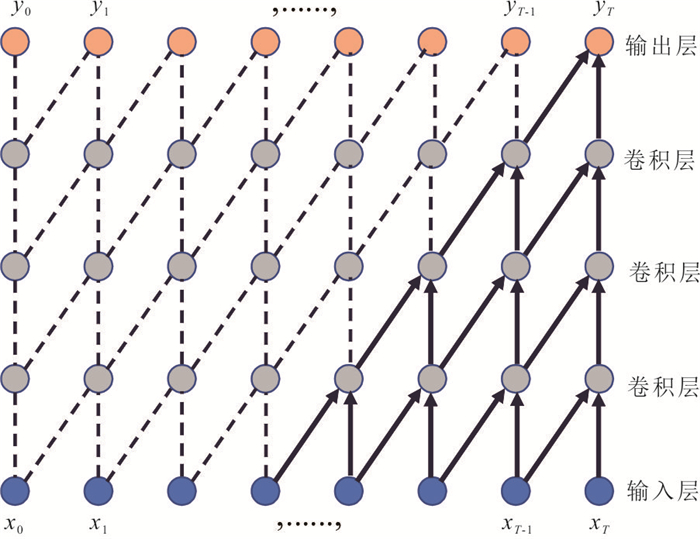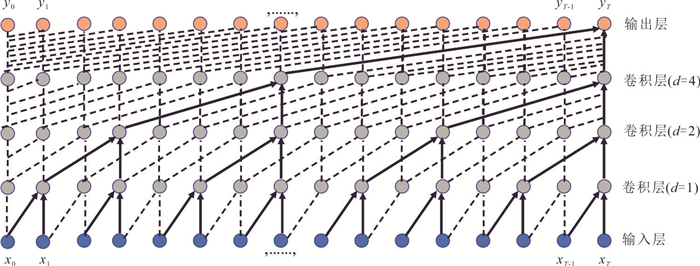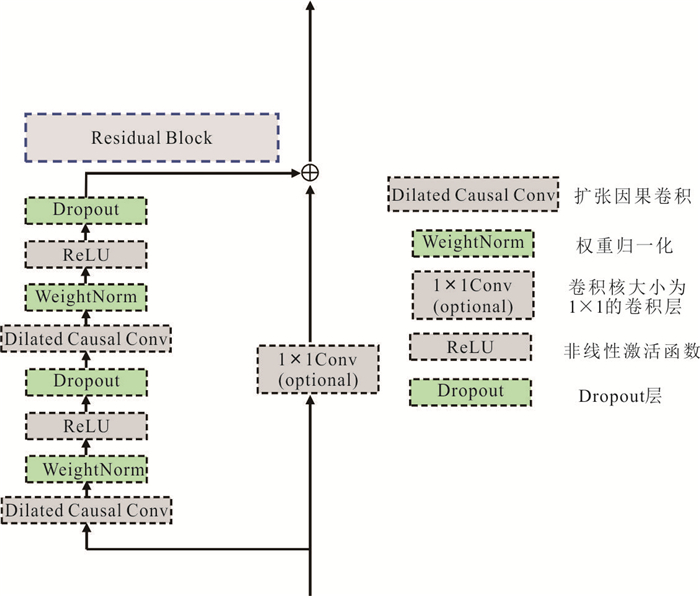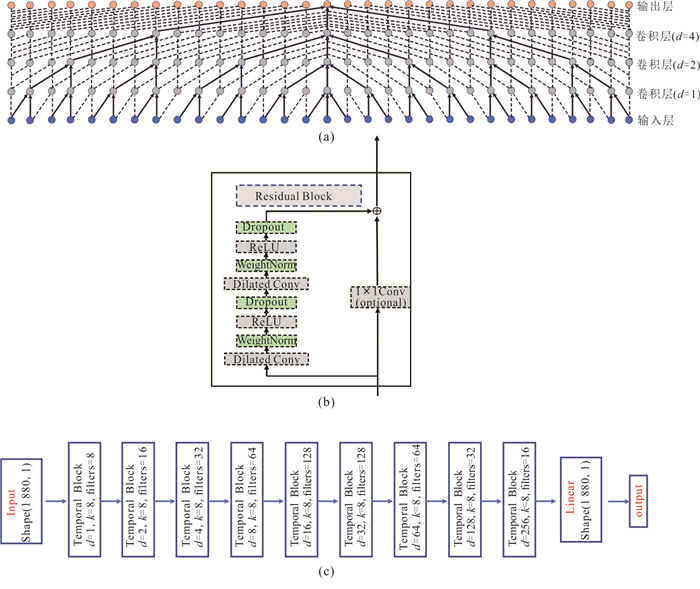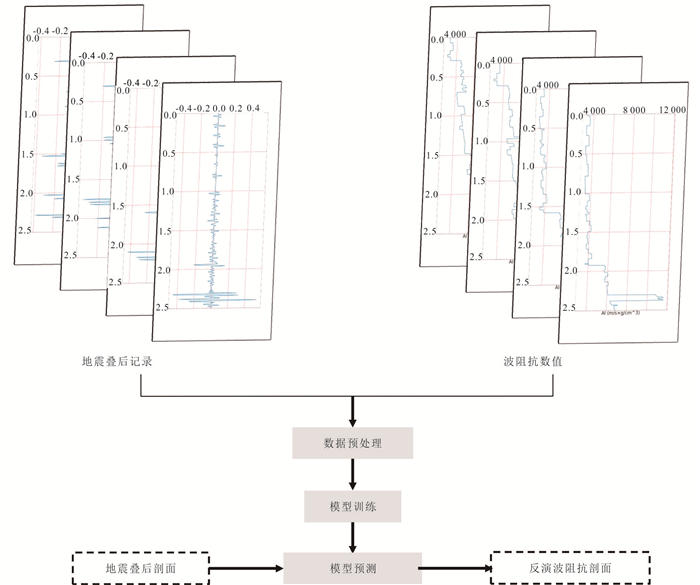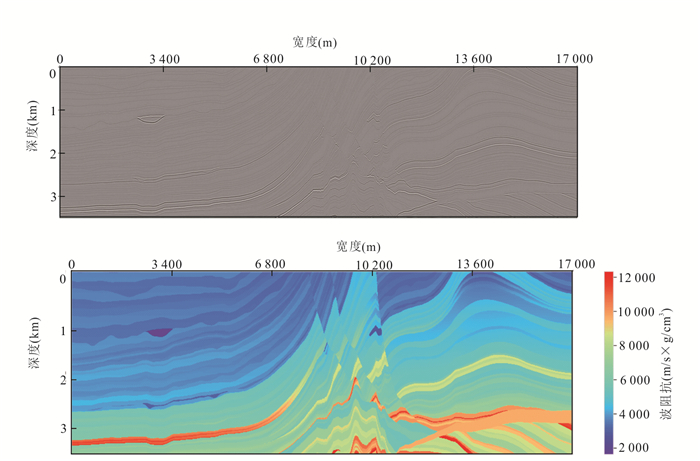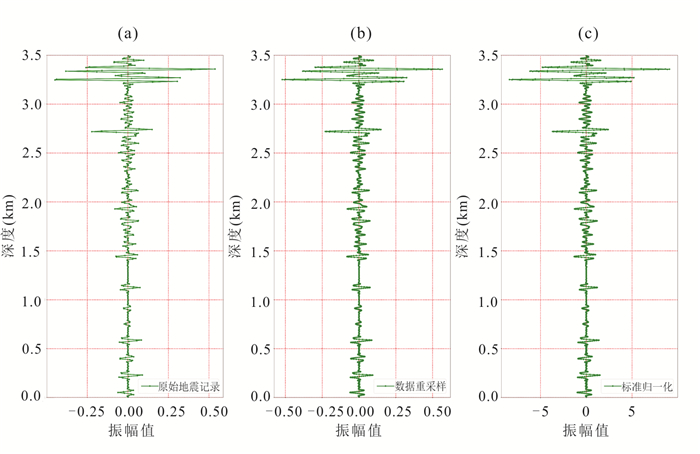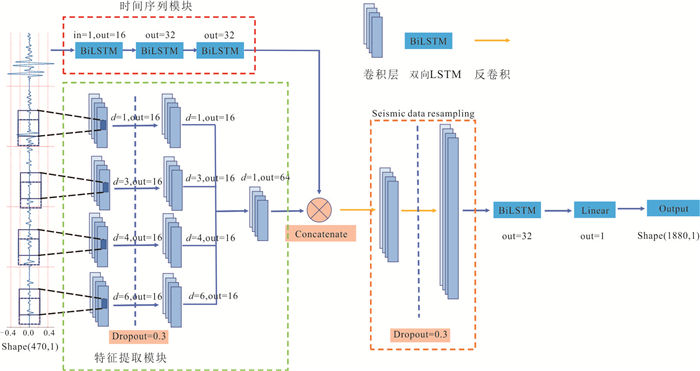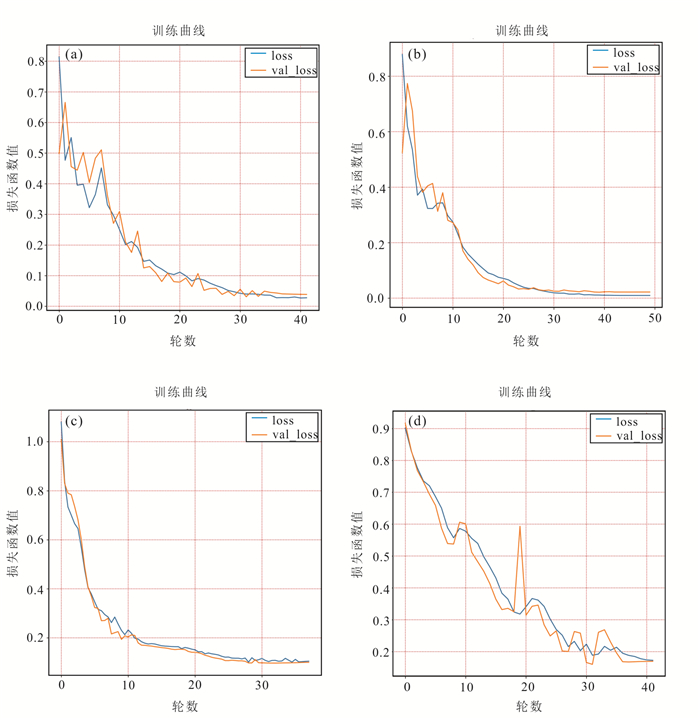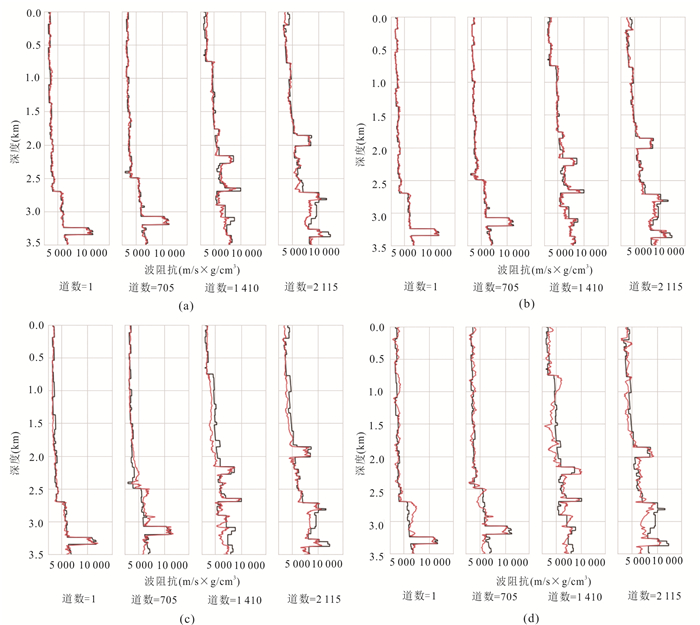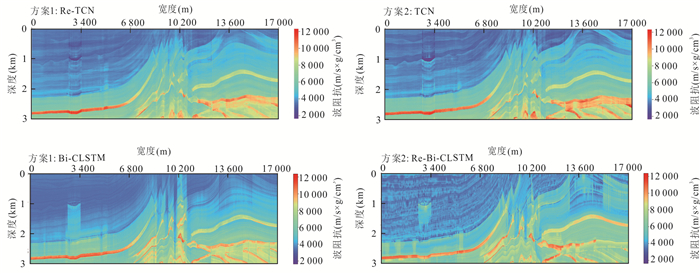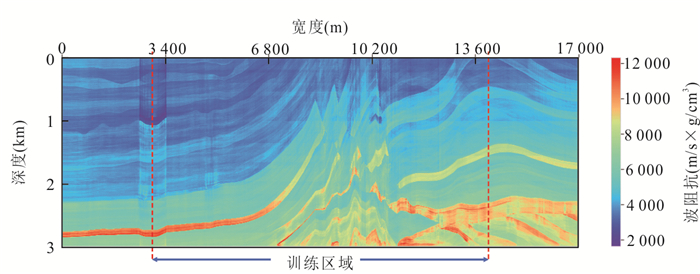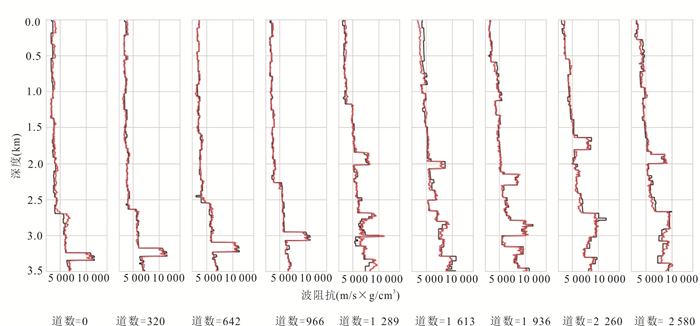Seismic Wave Impedance Inversion Based on Temporal Convolutional Network
-
摘要: 近些年来,深度学习网络的兴起极大地推动了人工智能技术在地震数据处理、反演以及解译等领域的应用.地震波阻抗反演是石油地震勘探领域的一项关键技术,其反演精度在圈定油气储层构造中起到非常重要的作用.提出了一种基于数据驱动时间卷积网络(temporal convolution network,TCN)模型的地震波阻抗反演方法,旨在无需建立初始反演模型,直接利用工区的少量测井标签数据,以地震振幅数据为输入,将波阻抗反演转化为时间序列建模任务,最终输出地下模型的阻抗信息.采用Marmousi2数据集对基于TCN的波阻抗反演模型进行训练、验证和测试,结果显示,在测试集上该模型预测结果的皮尔逊系数和决定系数分别达到97.92%和95.95%,并对远离训练区域的波阻抗信息预测有着良好的泛化性,且在预测时间和预测精度等方面都要明显优于前人的相关研究工作.上述结果表明,TCN时间序列深度学习模型在复杂地层波阻抗反演中具有一定优越性和应用前景,为地震波阻抗反演提供了新思路.Abstract: In recent years, the rising of deep learning has significantly boosted the application of artificial intelligence techniques in fields such as seismic data processing, inversion, and interpretation. As a key technology for seismic exploration in the petroleum industry, the precision of seismic wave impedance inversion is essential to characterize hydrocarbon reservoir. A new algorithm is proposed for derivations of wave impedance model from seismic record data using data-driven temporal convolution network (TCN). The proposed algorithm takes the seismic amplitude data as input without relying on the initial inversion model and outputs the impedance information of the subsurface model by utilizing a few well log tag data from the work area and transforming the wave impedance inversion into a time series modeling task. In this paper, the TCN wave impedance inversion model is trained, validated, and tested using the Marmousi2 dataset. The results show high Pearson correlation coefficient (97.92%) and coefficient of determination (95.95%), respectively, on the test set, and also suggest well generalization for predicting wave impedance information far from the training area, and the proposed model significantly out performs previous related work in terms of prediction time and precision. The above results show case the excellent performance of TCN time series model in wave impedance inversion of complex stratigraphic and provide a new idea for seismic wave impedance inversion.
-
Key words:
- wave impedance inversion /
- temporal convolutional network /
- deep learning /
- data driven /
- geophysics.
-
表 1 波阻抗反演的评价指标
Table 1. Evaluation index of wave impedance inversion
方案 模型 预测时间(s) 训练 测试 PCC r2 PCC r2 方案1 Re-TCN 10 0.984 9 0.970 2 0.971 1 0.943 8 Bi-CLSTM 119 0.961 4 0.924 7 0.955 9 0.914 4 方案2 TCN 9 0.994 4 0.988 8 0.979 2 0.959 5 Re-Bi-CLSTM 274 0.923 5 0.853 8 0.907 9 0.827 1 -
Alfarraj, M., AlRegib, G., 2018. Petrophysical-Property Estimation from Seismic Data Using Recurrent Neural Networks. SEG Technical Program Expanded Abstracts 2018, 2141-2146. https://doi.org/10.1190/segam2018-2995752.1 Alfarraj, M., Alregib, G., 2019. Semi-supervised Learning for Acoustic Impedance Inversion. SEG Technical Program Expanded Abstracts 2019. https://doi.org/10.1190/segam2019-3215902.1 Alregib, G., Deriche, M., Long, Z. L., et al., 2018. Subsurface Structure Analysis Using Computational Interpretation and Learning: A Visual Signal Processing Perspective. IEEE Signal Processing Magazine, 35(2): 82-98. https://doi.org/10.1109/MSP.2017.2785979 Badrinarayanan, V., Kendall, A., Cipolla, R., 2017. SegNet: A Deep Convolutional Encoder-Decoder Architecture for Image Segmentation. IEEE Transactions on Pattern Analysis and Machine Intelligence, 39(12): 2481-2495. https://doi.org/10.1109/TPAMI.2016.2644615 Bai, S. J., Kolter, J.Z., Koltun, V., 2018. An Empirical Evaluation of Generic Convolutional and Recurrent Networks Forsequence Modeling. arXiv Preprint arXiv: 1803.01271 Bing, P.P., Cao, S.Y., Lu, J.T., 2012. Non-Linear AVO Inversion Based on Support Vector Machine. Chinese Journal of Geophysics, 55(3): 1025-1032(in Chinese with English abstract). Buland, A., Omre, H., 2003. Bayesian Linearized AVO Inversion. Geophysics, 68(1): 185-198. https://doi.org/10.1190/1.1543206 Calderon-Macias, C., Sen, M.K., 1993. Geophysical Interpretation by Artificial Neural Systems: A Feasibility Study SEG Technical Program Expanded Abstracts 1993. Society of Exploration Geophysicists, 254-257. https://doi.org/10.1190/1.1822453 Das, V., Pollack, A., Wollner, U., et al., 2019. Convolutional Neural Network for Seismic Impedance Inversion. Geophysics, 84(6): R869-R880. https://doi.org/10.1190/geo2018-0838.1 Duijndam, A.J.W., 1988. Bayesian Estimation in Seismic Inversion. Part Ⅰ: Principles. Geophysical Prospecting, 36(8): 878-898. https://doi.org/10.1111/j.1365-2478.1988.tb02198.x Gholami, A., 2015. Nonlinear Multichannel Impedance Inversion by Total-Variation Regularization. Geophysics, 80(5): R217-R224. https://doi.org/10.1190/geo2015-0004.1 Gu, Y., Zhu, P.M., Rong, H., et al., 2013. Seismic Facies Classification Based on Bayesian Networks. Earth Science, 38(5): 1143-1152(in Chinese with English abstract). He, K. M., Zhang, X. Y., Ren, S. Q., et al., 2015. Delving Deep into Rectifiers: Surpassing Human-Level Performance on Image Net Classification. 2015 IEEE International Conference on Computer Vision (ICCV), Santiago, Chile, 1026-1034. https://doi.org/10.1109/ICCV.2015.123 He, K. M., Zhang, X. Y., Ren, S. Q., et al., 2016. Deep Residual Learning for Image Recognition. 2016 IEEE Conference on Computer Vision and Pattern Recognition (CVPR), Las Vegas, NV, USA, 770-778. https://doi.org/10.1109/CVPR.2016.90 He, Q.L., Wang, Y.F., 2021. Reparameterized Full-Waveform Inversion Using Deep Neural Networks. Geophysics, 86(1): V1-V13. https://doi.org/10.1190/geo2019-0382.1 Hochreiter, S., Schmidhuber, J., 1997. Long Short-Term Memory. Neural Computation, 9(8): 1735-1780. https://doi.org/10.1162/neco.1997.9.8.1735 LeCun, Y., Bottou, L., Bengio, Y., et al., 1998. Gradient-Based Learning Applied to Document Recognition. Proceedings of the IEEE, 86(11): 2278-2324. https://doi.org/10.1109/5.726791 Li, M., Li, Y., Wu, N., et al., 2020a. Desert Seismic Random Noise Reduction Framework Based on Improved PSO-SVM. Acta Geodaetica et Geophysica, 55(1): 101-117. https://doi.org/10.1007/s40328-019-00283-3 Li, S.C., Liu, B., Ren, Y.X., et al., 2020b. Deep-Learning Inversion of Seismic Data. IEEE Transactions on Geoscience and Remote Sensing, 58(3): 2135-2149. https://doi.org/10.1109/TGRS.2019.2953473 Li, X.G., Wu, X., 2020. Progresses of Artificial Intelligence on Seismic Data Processing and Interpretation Reviewed from SEG Annual Meetings. World Petroleum Industry, 27(4): 27-35(in Chinese with English abstract). Liu, Z.L., Lu, Z.W., Jia, J.L., et al., 2019. Using Deep Seismic Reflection to Profile Deep Structure of Ore Concentrated Area: Current Status and Case Histories. Earth Science, 44(6): 2084-2105(in Chinese with English abstract). Martin, G.S., Wiley, R., Marfurt, K.J., 2006. Marmousi2: An Elastic Upgrade for Marmousi. The Leading Edge Nair, 25(2): 156-166. https://doi.org/10.1190/1.2172306 Nair, V., Hinton, G.E., 2010. Rectified Linear Units Improve Restricted Boltzmann Machines. Proceedings of the 27th International Conference on Machine Learning (ICML-10), Israel, 807-814. Puzyrev, V., Egorov, A., Pirogova, A., et al., 2019. Seismic Inversion with Deep Neural Networks: A Feasibility Analysis 81st EAGE Conference and Exhibition 2019. European Association of Geoscientists & Engineers, London, UK, 1-5. https://doi.org/10.3997/2214-4609.201900765 Srivastava, N., Hinton, G., Krizhevsky, A., et al., 2014. Dropout: A Simple Way to Prevent Neural Networks from Overfitting. Journal of Machine Learning Research, 15: 1929-1958. Tan, F.Q., Li, H.Q., Xu, C.F., et al., 2012. Reservoir Classification of Conglomerate Reservoir Base on Clustering Analysis Method. Progress in Geophysics, 27(1): 246-254(in Chinese with English abstract). Xu, P., Lu, W., Tang, J., et al., 2019. High-Resolution Reservoir Prediction Using Convolutional Neural Networks 81st EAGE Conference and Exhibition 2019. European Association of Geoscientists & Engineers, London, UK, 1-5. https://doi.org/10.3997/2214-4609.201901392 Yang, P.J., Yin, X.Y., 2008. Prestack Seismic Inversion Method Based on Support Vector Machine. Journal of China University of Petroleum (Edition of Natural Science), 32(1): 37-41(in Chinese with English abstract). 邴萍萍, 曹思远, 路交通, 2012. 基于支持向量机的非线性AVO反演. 地球物理学报, 55(3): 1025-1032. doi: 10.6038/j.issn.0001-5733.2012.03.033 顾元, 朱培民, 荣辉, 等, 2013. 基于贝叶斯网络的地震相分类. 地球科学, 38(5): 1143-1152. doi: 10.3799/dqkx.2013.114 李晓光, 吴潇, 2020. 从SEG年会看人工智能在地震数据处理与解释中的新进展. 世界石油工业, 27(4): 27-35. https://www.cnki.com.cn/Article/CJFDTOTAL-SSYY202004007.htm 刘子龙, 卢占武, 贾君莲, 等, 2019. 利用深地震反射剖面开展矿集区深部结构的探测: 现状与实例. 地球科学, 44(6): 2084-2105. doi: 10.3799/dqkx.2019.020 谭锋奇, 李洪奇, 许长福, 等, 2012. 基于聚类分析方法的砾岩油藏储层类型划分. 地球物理学进展, 27(1): 246-254. https://www.cnki.com.cn/Article/CJFDTOTAL-DQWJ201201028.htm 杨培杰, 印兴耀, 2008. 基于支持向量机的叠前地震反演方法. 中国石油大学学报(自然科学版), 32(1): 37-41. doi: 10.3321/j.issn:1673-5005.2008.01.008 -










 下载:
下载:
